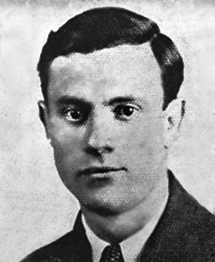Holocaust Education & Archive Research Team |
Revolt & Resistance
Acts of Resistance
Jewish Resistance
Groups Jewish Resistors Allied Reports Anti-Nazi Resistance Nazi collaborators
| |||
Aharon Liebeskind Jewish Underground Leader
Aharon Liebeskind was born in Zabierzow, a village near Krakow in 1912, and he studied law at Krakow University. In 1938 he became secretary of the Akiva movement, which he had joined at the age of fourteen. In early 1939 he was appointed national secretary of Akiva and went to live in Warsaw, although he kept his home in Krakow as well, and continued to lead the movement there.
As well as the above commitments he also managed to complete his doctoral dissertation. His job kept him in Warsaw until the outbreak of the war. From the outset of the German occupation of Poland, Liebeskind was convinced that the Jews would not be able to live under the Nazis, and he did all he could to get the members of his movement out of Poland.
Liebeskind was a charismatic figure, much admired by his fellow members and followers. He did not accept an immigration certificate to Palestine for himself, so as not to abandon his family and followers during these dark times.
In December 1940 Liebeskind was put in charge of an agricultural and vocational training programme in the Krakow area, sponsored by the Jewish Self-Help Society, which had it’s headquarters in Krakow.
He utilised his position to promote the activities of the Jewish underground in the city, which he had founded and led. Using the society’s official stationery, he distributed leaflets and arranged money transfers to the members of the underground.
Liebeskind also arranged for the financing of the Kopaliny training farm, headed by Shimshon Draenger, which served as a cover for underground operations. His post enabled him to move around and thereby to maintain and strengthen contact with fellow members in various locations.
Having learned about the mass murder of Jews in the Chelmno killing center and the deportations from Cracow to the Belzec death camp in June 1942, the Jewish fighters decided to respond with armed resistance against the Nazis.
Using couriers like Hela Schüpper, the leaders of this group established contact with other Jewish resistance groups in Warsaw, Tarnow, and Rzeszow, obtained valuable information, and smuggled weapons back into the ghetto. They sent commando groups out into the nearby forests to link up with the partisans and set up a forgery workshop, under Shimson Draenger, to create false papers and documents.
He is credited with saying that, “the Jewish fighters are fighting for three lines in history.” He initiated the established of a broadly based fighting organisation in Krakow, forging ties with the other leaders of the He- Haluts (pioneer) youth organisations in the city.
An especially close tie existed between Liebeskind and Avraham Leibovich (Laban) of the Dror movement, and the two became the commanders of the resistance organisation, the Fighting Organisation of the Pioneering Jewish Youth (He-Haluts ha-Lohem).
In October 1942, the two resistance groups joined together to form the Jewish Fighting Organization (JFO). In the months that followed, the JFO operated outside the ghetto, sabotaging rail lines, raiding German warehouses, and attacking German soldiers and security police.
On December 22, the Jewish fighters carried out their boldest plan—a series of attacks on German forces throughout the city. Members of the JFO were to throw grenades into three cafés where German officers congregated, sabotage army and police vehicles, distribute anti-Nazi leaflets, raise Polish flags on the bridges over the Vistula, and assassinate German soldiers throughout the city.
At the Cyganeria café, the fighters killed at least seven German officers and wounded many more. In the wake of these attacks, German authorities launched a massive manhunt to find the resistance fighters and Leibovich was captured by the Germans in December 1942, was taken with other Jewish resistance fighters on the 29 April 1943 by trucks to the Plaszow Labour Camp.
During the short drive from the prison to the Labour Camp they were able to escape from the truck. Most of them were murdered by machined-gun fire.
Among the few who escaped being shot was Avraham Leibovich, but he was recaptured and taken to Plaszow and killed.
Since the Gestapo began its major endeavor to pursue him, Liebeskind and the organisation’s headquarters moved to the “Aryan” part of the city in November of 1942.
From there he renewed contact with the Polish Communist Workers Party (PPR) – which had been broken off in the wake of an abortive attempt made in September 1942 to leave the Krakow ghetto and take refuge in the forests – and with its Jewish unit, commanded by Heshek (Zvi) Bauminger.
Liebeskind aim was to launch a large-scale attack on the Germans inside Krakow. On the 22 December 1942, He-Haluts ha-Lohem and the Jewish unit of the PPR attacked German targets in Krakow.
They inflicted many casualties on the Germans, but following the attack, the headquarters and most of the members of He-Haluts ha- Lohem fell into German hands.
On the 24 December 1942 Liebeskind was caught in the headquarters bunker and killed in a hand-to-hand fight.
Sources:
Encyclopaedia of the Holocaust The Holocaust, by Sir Martin Gilbert, published by Collins London 1986 Wiener Library USHMM Hilberg, Raul. " The Destruction of the European Jews " Yale University Press, 2003 edition.
Copyright: Anthony Skelton & Victor Smart H.E.A.R.T 2008
|




